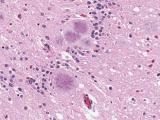May 26, 2004 (CIDRAP News) – An analysis of thousands of samples of appendix tissue in the United Kingdom (UK) suggests that the number of future cases of variant Creutzfeldt-Jakob (vCJD) disease there could turn out to be higher than expected.
In examining tissue samples from thousands of patients who underwent appendectomies and tonsillectomies, researchers found three appendix samples with an accumulation of abnormal prion protein, the misfolded protein associated with the brain-wasting disease. The finding suggests the patients had preclinical cases of vCJD, according to the report in the Journal of Pathology.
If the prion protein accumulation predicts vCJD—which is not certain—the finding suggests that about 3,800 young people in Britain may be incubating the disease, the report says. That compares with a recent estimate that only 540 more cases would occur there.
Eating meat products from cattle with bovine spongiform encephalopathy (BSE), or mad cow disease, is believed to be the cause of vCJD. The emergence of vCJD in Britain in the 1990s followed a large number of BSE cases in British cattle herds starting in the late 1980s. The UK Department of Health reports that 141 people in the UK have died of vCJD, which can be definitely diagnosed only after death.
The report by David A. Hilton of Derriford Hospital in Plymouth, UK, and colleagues says that an accumulation of prion protein in the lymphoreticular system has been found in all cases of symptomatic vCJD examined so far. In addition, prion protein was found in appendix tissue from two patients before the onset of vCJD symptoms, according to an earlier report.
To look for signs of a large vCJD epidemic, the authors examined appendix and tonsil samples from 16,703 patients across Britain. The study included 14,964 appendix specimens, mostly from patients in their 20s (the age-group at highest risk for vCJD), and 1,739 tonsil specimens from patients of all ages.
The investigators used an immunohistochemistry technique involving monoclonal antibodies to detect abnormal prion protein in the samples. About 25% of the samples were excluded from the final analysis because they didn't contain enough lymphoid tissue. None of the tonsil samples tested positive for abnormal prion protein, but 3 out of 12,674 appendix samples did.
If the findings are a reliable sign of preclinical vCJD, "the estimated prevalence of vCJD based on these three positive samples in 12,674 tested will be 237 infections per million population" (95% confidence interval [CI], 49 to 692 per million), the report states. The best estimate based on this is that 3,808 Britons between the ages of 10 and 30 (who accounted for 83% of the sample) are incubating vCJD, the article says.
The pattern of staining seen in one of the three samples was similar to that seen previously in appendix tissue from two patients who later fell ill with vCJD. In the other two cases the staining pattern differed somewhat from that seen in previous known cases. If only the one case with the similar pattern is considered to predict the disease, the estimated prevalence of preclinical cases is 79 per million people, the report says. "In contrast to these high estimates, clinical case numbers remain at a much lower level and have been declining since 2000," the authors note.
The report says it is not certain that the accumulation of prion protein in lymphoid tissue is a true marker of preclinical vCJD. The phenomenon has not been seen in any other disease, but there are some possible alternative explanations for it, they write. No further investigation of the positive cases was possible, because the study was designed to keep the patients anonymous.
People with subclinical vCJD could pose a risk to others because the disease can be transmitted via surgical instruments and possibly by blood transfusions, the article says. "Our findings therefore reinforce the importance of recent steps taken by the Department of Health to reduce these potential risks," it states. The findings also point to a need for prospective screening of tissue from tonsillectomies, the authors write.
Hilton DA, GhaniAC, Conyers L, et al. Prevalence of lymphoreticular prion protein accumulation in UK tissue samples. J Pathol 2004;early online publication [Abstract]
















